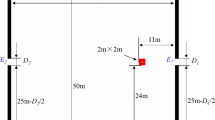Abstract
The occurrence of accident such as fire in high living density places like in a college dormitory building can cause serious personnel injuries, property loss and social impacts. The aim of this study is to develop a standard operational procedure (SOP) for fire safety evacuation in college dormitory buildings by evaluating fire safety evacuation capacity through simulation and comparison under four different scenarios. This study endeavored to explore a suitable way to simulate the evacuation process in high-density dormitory buildings under a fire situation and to put forward a general SOP to evaluate the fire safety evacuation capacity. The fire evacuation capacity was investigated under four different scenarios revealing that the dormitory building structure, living density and time of fire occurrence are three key factors. The standard operational procedures (SOP) developed in this study is applicable to fire evacuation simulation for college dormitories with reasonable universality.
Graphic abstract



























Similar content being viewed by others
References
Adjiski V, Mirakovski D, Despodov Z, Mijalkovski S (2015) Simulation and optimization of evacuation routes in case of fire in underground mines. J Sustain Mining 14(3):133–143
Bs A, Lab C, Asb D (2020) A map representation of the ASET-RSET concept. Fire Saf J 115:103154
Cao S, Fu L, Song W (2018) Exit selection and pedestrian movement in a room with two exits under fire emergency. Appl Math Comput 332:136–147
Chen X, Liu C, Wu I (2018) A BIM-based visualization and warning system for fire rescue. Adv Eng Inform 37:42–53
Etges BMBD, Pereira BB, Silveira TJSD (2018) A lean approach to improve productivity in a coke oven refurbishment project: a case study. In: 26th Annual conference of the international group for lean construction. Chennai, India
Hietaniemi J, Kallonen R, Mikkola E (1999) Burning characteristics of selected substances: production of heat, smoke and chemical species. Fire Mater 23(4):171–185
Isobe M, Helbing D, Nagatani T (2004) Experiment, theory, and simulation of the evacuation of a room without visibility. Phys Rev Stat Nonlin Soft Matter Phys 69:66132
Klote J (1993) A method for calculation of elevator evacuation time. J Fire Prot Eng 5:83–95
Lei W, Li A, Gao R, Zhou N, Mei S, Tian Z (2012) Experimental study and numerical simulation of evacuation from a dormitory. Phys A 391(21):5189–5196
Lei W, Li A, Gao R (2013) Effect of varying two key parameters in simulating evacuation for a dormitory in China. Phys A 392(1):79–88
Li Z, Liu Y, Krigsvoll G, Johansen F (2018) Life cycle assessment and life cycle cost of university dormitories in the southeast China: case study of the university town of Fuzhou. J Clean Prod 173:151–159
Löffel S, Walls R (2020) Development of a full-scale testing methodology for benchmarking fire suppression systems for use in informal settlement dwellings. Int J Disas Risk Reduc 45:101451
Ma G, Wu Z (2020) BIM-based building fire emergency management: Combining building users’ behavior decisions. Autom Construct 109:102975
Ma Z, Li J, Yue Z (2016) Research on fire safety emergency evacuation of college. Fire Sci Technol 7:21–34
Ronchi E (2020) Developing and validating evacuation models for fire safety engineering. Fire Safety J 103020. Available online 10 May 2020 (in press)
Sun Q, Turkan Y (2020) A BIM-based simulation framework for fire safety management and investigation of the critical factors affecting human evacuation performance. Adv Eng Inform 44:101093
Wang S, Wang W, Wang K, Shih S (2015) Applying building information modeling to support fire safety management. Autom Constr 59:158–167
Wang Z, Wang X, Huang Y, Tao C, Zhang H (2018) Experimental study on fire smoke control using water mist curtain in channel. J Hazard Mater 342:231–241
Zhang L, Shi LS (2019) the platform design and implementation of campus fire safety knowledge based on unity3D. Procedia Comput Sci 154:832–837
Author information
Authors and Affiliations
Corresponding author
Additional information
Publisher's Note
Springer Nature remains neutral with regard to jurisdictional claims in published maps and institutional affiliations.
Rights and permissions
About this article
Cite this article
Jiang, S., Wang, C., Bimenyimana, S. et al. Standard operational procedures (SOP) for effective fire safety evacuation visualization in college dormitory buildings. J Vis 24, 1207–1235 (2021). https://doi.org/10.1007/s12650-021-00761-3
Received:
Revised:
Accepted:
Published:
Issue Date:
DOI: https://doi.org/10.1007/s12650-021-00761-3




